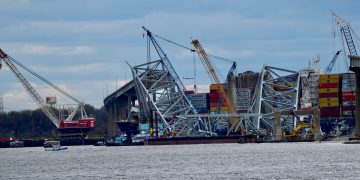In the light of a recent death of a vessel pilot who died when a gangway separated from a vessel, USCG issued a marine safety alert describing measures to ensure safe operation when it comes to gangways and ladders.
Recently, a vessel pilot died while boarding a vessel when its gangway separated from the vessel, causing two persons to fall into the water. Although the investigation is ongoing and more facts are being collected, this reminds that shipboard equipment that seems quite benign can quickly become a hazard to persons boarding and departing a vessel.
[smlsubform prepend=”GET THE SAFETY4SEA IN YOUR INBOX!” showname=false emailtxt=”” emailholder=”Enter your email address” showsubmit=true submittxt=”Submit” jsthanks=false thankyou=”Thank you for subscribing to our mailing list”]
Commercial vessels can present hazards to mariners onboard if the risks are not recognized and mitigated. Considering the hazards presented by rotating machinery, electrical systems, potential fire, severe weather, etc.; one could easily underappreciate the risk that a simple gangway presents, leading mariners to become complacent. Because of injuries and fatalities on gangways, many organizations have set out gangway safety standards, requirements, and best practices.
The Occupational Safety and Health Administration (OSHA), International Maritime Organization, Protection and Indemnity Clubs, and Owners and Operators have established various requirements and shared best practices to improve gangway safety, such as:
- The structure of the accommodation ladders and gangways and their fittings and attachments should be such as to allow regular inspection, maintenance of all parts;
- The means of embarkation and disembarkation should be sited clear of the working area and should not be placed where cargo or other suspended loads may pass overhead;
- Adequate lighting should be provided to illuminate the means of embarkation and disembarkation;
- The arrangement at the head of the accommodation ladder should provide direct access between the ladder and the ship’s deck by a platform securely guarded by handrails and adequate handholds. The ladder should be securely attached to the ship to prevent overturning;
- Each accommodation ladder or gangway should be clearly marked at each end with a plate showing the restrictions on the safe operation and loading;
- After installation, the winch and the accommodation ladder should be operationally tested;
- Gangways should never be secured to a ship’s guardrails unless they have been designed for that purpose;
- Accommodation ladders and gangways, including associate winch and fittings, should be properly maintained and inspected at appropriate intervals as required by SOLAS regulation III/20.7.2.
Because of this recent fatality, USCG strongly recommends:
- Owners and Operators, Captains and Mates review and implement the best practices as presented in the links above and comply with all the regulations applicable to your vessel.
- For vessel pilots, crews, vendors, or anyone boarding or departing a vessel, condition yourself to take a moment to examine the gangway, accommodation or pilot ladder. Look for potential hazards or deficiencies, and report them to senior personnel on board the vessel.
At all times, if there is any question about the safety of a gangway, DO NOT CROSS IT. Do not assume that any gangway crossing is “routine.”
You can see more in the PDF herebelow



































































all recommendations I read about accommodation ladders are related to rig them as well as maintenance. I would be interested to read as well about best practices securing accommodation ladders as many incidents occurs with crewmembers after pilot disembarkation or departing from berth